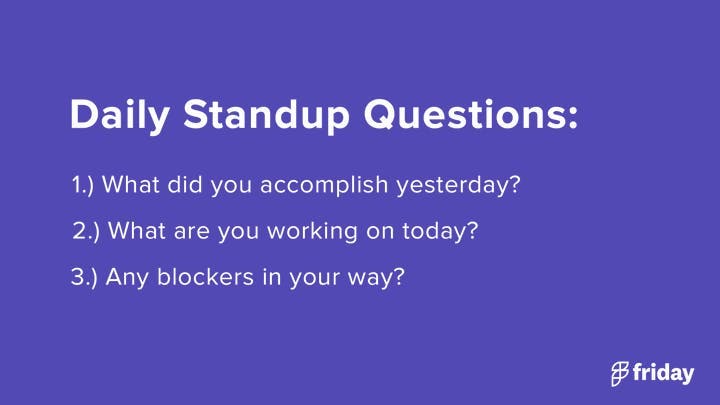Daily Standup Meetings: Everything You Should Know

Daily standup meetings are a popular agile ceremony, especially for engineering and development teams. This daily habit helps align a team and share progress, stay accountable, and resolve potential problems quickly.
The purpose of this post is to share everything you need to know about this cadence. If you are new to this meeting or want to improve an existing standup, you've found the right place.
In this guide we will cover the following:
- The purpose of a daily standup and its origins
- Why this cadence is important
- What questions you need to ask
- How to run a standup (as a team leader)
- Potential pitfalls and traps to avoid
- Running standups as a remote team
- Optimizing
The origin of the daily standup meeting
The origin story of the daily standup meeting (also known as a daily scrum) is described by Jeff Sutherland in this post. Specifically, they started investigating how the high-performing engineering organizations did their work and stumbled across this paper.
In this study, a team of eight engineers wrote one million lines of cover over thirty-one months (each person wrote 1k lines of code every week). One of their success factors was a daily meeting where they'd sync up on the project.
Here's specifically what the paper said:
"The core architecture team met daily to hammer out C++ class interfaces, to discuss overall algorithms and approaches, and to develop the basic underlying mechanisms on which the system would be built. These daily meetings were several hours in duration; from what I heard, the project was made more of meetings than anything else.
As Jeff writes in his post, they adapted this idea, reduced the meeting time and formalized this as a key operating process that happens every day.
What is the point of these meetings?
If you think about the average work day, there's two major modes of work, especially for engineering teams:
- Production - doing the work (writing the code)
- Coordination - coordination with the rest of the team (figuring out who's working on what)
Engineering teams require more coordination than other functions like marketing or sales. A sales rep could operate autonomously most of the time. If you have eight engineers working on a single codebase, the probability that people will step on each other's toes is high.
To use a sports analogy, engineering is a bit more like football, while other departments are more like running a race by yourself. These meeting are less about status reporting to external stakeholders, and more about internal coordination.
What is the difference between a daily standup and a daily scrum?
Technically, a daily scrum meeting is meant only for the development team, led by the Scrum master, and follows exactly with Scrum methodology, such as a 15 minute time boxing. It also outlines the tasks for the day.
Daily standup meetings are more informal, and includes more stakeholders such as the product owner. The development team may also be involved, or only a team leader, Scrum master, or a senior engineering manager. This meeting also identifies more blockers and resource allocation compared to the daily scrum meeting.
Many teams use the meetings interchangeably.
Why is the daily standup important?
The point of the daily standup meeting is to aid team coordination. This fast feedback loop helps teams align and stay on track, which is similar to a huddle in football. If an issue pops up, you can address it quickly and keep projects on track.
Without a quick feedback loop, one person may be stepping on another's toes. It's possible they may be working on the wrong task. It's possible they may need help on a problem.
The daily standup makes the assumption that these potential problems are normal and seeks a way to address them from a procedural (or structural level).
What are the rules for a daily standup meeting?
In his post, Sutherland addressed three key points that every standup meeting should include:
1. The meeting must be held every day at the same time, and everyone on the team must be present.
2. The daily standup meeting can't last more than 15 minutes.
3. Everyone must participate in the meeting and actively listen
What are the daily standup questions?
In the daily standup meeting, the goal is to answer the three questions shown below:
- What did you accomplish yesterday?
- What will you do today?
- Any blockers in your way?

Let's break them down.
1. What did you accomplish yesterday?
The purpose of this question is to relay information and share recent accomplishments. This helps give teams a sense of progress. To use the sports analogy, the answer to this question helps give you awareness of where others are on the field.
2. What will you do today?
The point of this question is to show where you are going today. This serves two purposes:
- It helps align the group around what others are doing, giving visibility and awareness
- It can be a useful way to create accountability. When you commit to doing something and share it with others, you are more likely to deliver on that commitment.
If you aren't thoughtful with discussion around this question, a daily standup can turn into a status update meeting, which is an epic waste of time.
3. Any blockers?
This might be the most important question and also the most difficult to surface. This question is important because you don't want people on your team to sit around waiting for someone else.
The goal is for each person to move in their own "swim lane", with as few impediments as possible.
The issue with this question is that people can hesitate to share that someone else is blocking them. It doesn't really look that great to be that person who's blocking someone else.
How do I run a standup meeting?
If you are a team leader, facilitating a daily standup meeting isn't rocket science. Here's some tips and best practices below:
- It should happen at a predictable time every day - you are trying to create a habit here. Holding these meetings at random times doesn't help create a habit
- It should be short and impactful - aim for fifteen minutes or less. If you are in-person, people should literally stand up if they can. You may need to pull people back on track if they start side discussions.
- Everyone should contribute, including you - there's nothing more annoying than a team leader who holds a meeting, but doesn't participate. It sends a signal that you are above the rest of the team. I'd strongly recommend you avoid doing this.
- You should be respectful of everyone's time - we'll discuss this more in the next section
Can you have a daily standup meeting with a remote team?
The short answer is yes, it's possible to have a daily stand up meeting with a remote team. We'll analyze the two different ways below.
For those running a synchronous (real-time) remote daily standup...
I've worked remotely for several years and participated and lead hundreds of real-time daily standups. If you are part of a remote team standup, I'd recommend focusing on the following additional variables:
- Spend a bit more time building relationships - it's nice to see and share what happened over the weekend, or to shoot the breeze and engage in some casual discussion before kicking things off. For example, at a past company, we'd read a daily quote from the Quotionary at the end. It was a cheesy, but fun way to bond before we tackled the day.
- Turn video on - people should turn on their video in these calls. It's way too easy not to pay attention with video off, especially if the meeting is fifteen minutes.
What pitfalls should I avoid?
Do everything you can to avoid letting the meeting drag on. It's very easy for someone to want to unpack what someone just said in the middle of the daily standup. Most of the time, this discussion should happen outside of the meeting, as most of the time it's only relevant to a few of the individuals and not the broader group.
For example, if two engineers are working on a billing system, while the other three engineers are working on another project, spending time to talk about the billing system may not be relevant to the three engineers who aren't involved.
Additionally, don't be late. If you are five minutes late for a meeting and there are four team members that are waiting for you, that's twenty minutes of collective time that's wasted (4 people x 5 minutes each).
Can you have asynchronous standups as a remote team?
Many remote teams will share this information asynchronously instead of holding a real-time meeting. This is primarily a result of having various team members in different locations. When you are remote, the cost of coordination tends to be higher. Additionally, many remote teams try to create a flexible work environment, which means reducing the number of meetings people have on a regular basis.
At Friday, we are huge fans of async daily standups that either replace or complement the meeting and make it more efficient.
Why asynchronous daily standups are more efficient
The reasoning is simple. If you get the information-sharing done before the meeting starts, you can focus more time on resolving blockers and spend more time building relationships.
Let's wrap up this guide by discussing how you can optimize the efficiency of these meetings in the next section.
How To Optimize Your Daily Standup Meeting
Here are a few final tips to make the most of these meetings, especially if you run them asynchronously:
- If it doesn't persist, it doesn't exist - if you write down your dailystandup responses, you can create a running log of notes that can be referenced over time.
- Consider eliminating the first question - if people write down their responses and the record is stored over time, you don't necessarily need to constantly share what you did yesterday...as it's already recorded and accessible
- Benchmark responses over time - consider asking questions that can be quantified over time. For example, "on a scale of 1-10, how productive were you yesterday?" or asking via emojis.
The final point is to consider external stakeholders. If you have a report available, you can easily share progress without dragging external stakeholders into meetings (which no one likes).
Conclusion: Effective Standup Meetings Can Be Done!
To wrap things up, daily standups are a wonderful way to stay on the same page, but make sure to keep them efficient! A simple fifteen meeting every day can cost thousands of dollars in time cost.

